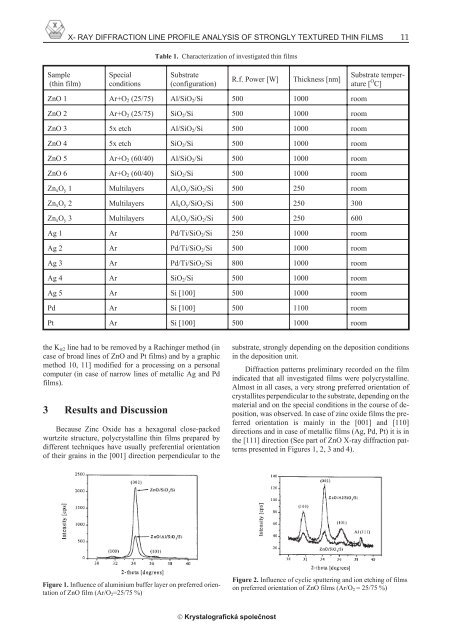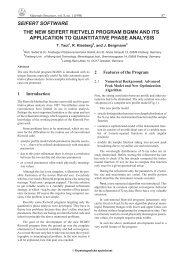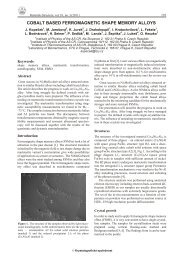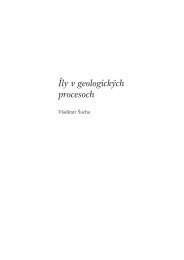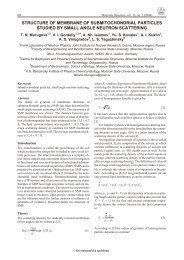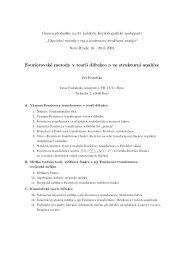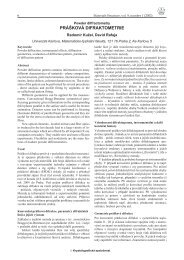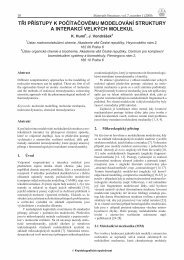x- ray diffraction line profile analysis of strongly textured thin films
x- ray diffraction line profile analysis of strongly textured thin films
x- ray diffraction line profile analysis of strongly textured thin films
Create successful ePaper yourself
Turn your PDF publications into a flip-book with our unique Google optimized e-Paper software.
X- RAY DIFFRACTION LINE PROFILE ANALYSIS OF STRONGLY TEXTURED THIN FILMS 11<br />
Table 1. Characterization <strong>of</strong> investigated <strong>thin</strong> <strong>films</strong><br />
Sample<br />
(<strong>thin</strong> film)<br />
Special<br />
conditions<br />
Substrate<br />
(configuration)<br />
R.f. Power [W]<br />
Thickness [nm]<br />
Substrate temperature<br />
[ O C]<br />
ZnO 1 Ar+O 2 (25/75) Al/SiO 2 /Si 500 1000 room<br />
ZnO 2 Ar+O 2 (25/75) SiO 2 /Si 500 1000 room<br />
ZnO 3 5x etch Al/SiO 2 /Si 500 1000 room<br />
ZnO 4 5x etch SiO 2 /Si 500 1000 room<br />
ZnO 5 Ar+O 2 (60/40) Al/SiO 2 /Si 500 1000 room<br />
ZnO 6 Ar+O 2 (60/40) SiO 2 /Si 500 1000 room<br />
Zn x O y 1 Multilayers Al x O y /SiO 2 /Si 500 250 room<br />
Zn x O y 2 Multilayers Al x O y /SiO 2 /Si 500 250 300<br />
Zn x O y 3 Multilayers Al x O y /SiO 2 /Si 500 250 600<br />
Ag 1 Ar Pd/Ti/SiO 2 /Si 250 1000 room<br />
Ag 2 Ar Pd/Ti/SiO 2 /Si 500 1000 room<br />
Ag 3 Ar Pd/Ti/SiO 2 /Si 800 1000 room<br />
Ag 4 Ar SiO 2 /Si 500 1000 room<br />
Ag 5 Ar Si [100] 500 1000 room<br />
Pd Ar Si [100] 500 1100 room<br />
Pt Ar Si [100] 500 1000 room<br />
the K α2 <strong>line</strong> had to be removed by a Rachinger method (in<br />
case <strong>of</strong> broad <strong>line</strong>s <strong>of</strong> ZnO and Pt <strong>films</strong>) and by a graphic<br />
method 10, 11] modified for a processing on a personal<br />
computer (in case <strong>of</strong> narrow <strong>line</strong>s <strong>of</strong> metallic Ag and Pd<br />
<strong>films</strong>).<br />
3 Results and Discussion<br />
Because Zinc Oxide has a hexagonal close-packed<br />
wurtzite structure, polycrystal<strong>line</strong> <strong>thin</strong> <strong>films</strong> prepared by<br />
different techniques have usually preferential orientation<br />
<strong>of</strong> their grains in the [001] direction perpendicular to the<br />
substrate, <strong>strongly</strong> depending on the deposition conditions<br />
in the deposition unit.<br />
Diffraction patterns preliminary recorded on the film<br />
indicated that all investigated <strong>films</strong> were polycrystal<strong>line</strong>.<br />
Almost in all cases, a very strong preferred orientation <strong>of</strong><br />
crystallites perpendicular to the substrate, depending on the<br />
material and on the special conditions in the course <strong>of</strong> deposition,<br />
was observed. In case <strong>of</strong> zinc oxide <strong>films</strong> the preferred<br />
orientation is mainly in the [001] and [110]<br />
directions and in case <strong>of</strong> metallic <strong>films</strong> (Ag, Pd, Pt) it is in<br />
the [111] direction (See part <strong>of</strong> ZnO X-<strong>ray</strong> <strong>diffraction</strong> patterns<br />
presented in Figures 1, 2, 3 and 4).<br />
Figure 1. Influence <strong>of</strong> aluminium buffer layer on preferred orientation<br />
<strong>of</strong> ZnO film (Ar/O 2 =25/75 %)<br />
Figure 2. Influence <strong>of</strong> cyclic sputtering and ion etching <strong>of</strong> <strong>films</strong><br />
on preferred orientation <strong>of</strong> ZnO <strong>films</strong> (Ar/O 2 = 25/75 %)<br />
© Krystalografická spoleènost


